Project Description
Prototyping Discussion
Shortly after the result of the group assignment came out, our group members first met up together. We had a short group discussion together, to set up a general project direction which we may start from. The brainstorm brought us many ideas. Taking a few as examples, we had sleeping aid device, robots that help solve energy problems, magic drink bottles, etc. The discussion was highly efficient and productive, which helped boosted our project a lot.
Eventually, at the end of the discussion, we chose the idea of making a sensory interaction device from all of the prompts we came up with. This idea we had originates from the science fiction “The Veldt”. The fiction story depicts a slightly frightening but thought-provoking story, in which a pair of wealthy parents depend on an intelligent nursery room to educate their kids, who later turn out to be cold-blooded, over-intelligent and also over-dependent on the nursery room, and eventually murdered their parents. Our idea came from the nursery room in the fiction.
We based our idea on the nursery room. We wanted to invent an artifact that could provide immersive sensory interaction experience similarly like the functions of the nursery room. This artifact can provide you with simulative stimulations through five different dimensions: five basic human senses–vision, hearing, touch, smell, warmth. The artifact could generate its stimulations based on the user’s desires or moods, by which, the stimulations would be user-oriented, with specific themes accordingly.
After we decided, we started to draw scripts and diagrams.
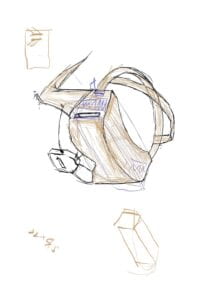
This is the script we drew for our device. We built our device model based on this script, using cardboard and wires.
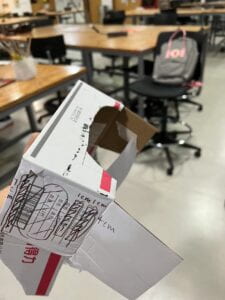
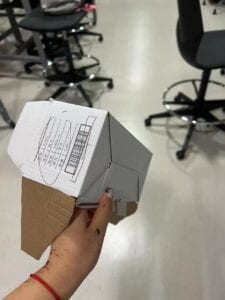
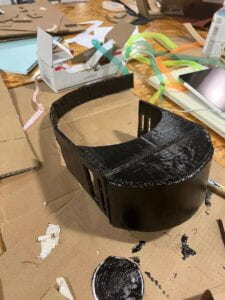
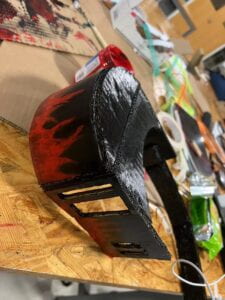
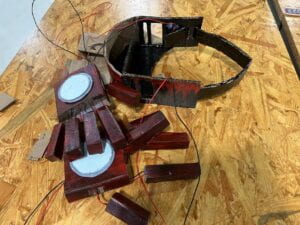
There are two sections: the head part and the hand parts. The head part provides feedbacks on vision, smell, hearing, and the hand part provides feedback on touch and warmth. There is a sensor in the head part, which can detect the electric signals in people’s brain, and analyze the signals which indicate what kind of mood the user is currently possessing.
This picture shows what it looks like when users put it on.
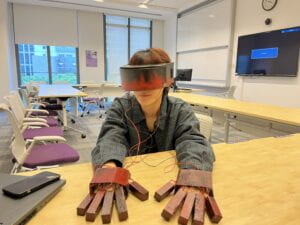
This idea shows a good connection with the previous two projects I examined in the research phase of this project. In both of the previous devices, there appears to be obvious processing procedures in which device processes what users’ feedback and users process device’s feedback. This device also shows this process. When the user detects the user’s mood, it provides stimulations. When the user receives the sensory stimulations, the user changes its mood, which generates a positive circulation. This device, in our imagination, can be used to alleviate the negative emotions such as depression, sadness, anxiety and so on in the life of contemporary people. For example, if a person has a lot of negative emotions due to the longtime of quarantine, and he really wants to go to the seaside, then with this device, it can take him into a virtual seaside world, where he can see, hear and even smell the sea.
There are similar technologies that this artifact may possibly be built on or even go beyond. We may identify that the head part of this artifact seems really similar as what we currently have known as “VR” technology, which refers to “Virtual Reality”. These two things do share certain level of resemblance between each other. As a result, what problems VR might have also could be applied to this device, for example, will people be over-dependent on this device? Is it a good sign that virtual technology gets stronger and more powerful day by day? These are critical questions we came up with during our brainstorming process.
Performing
About the performance, the members of our group first had a meeting together. We started thinking about how we could show the functionality of our devices. We each offered some suggestions, and eventually mine was adopted. There are two main characters in the show, the psychiatrist and the student. One of our team members plays a student who is troubled by a heavy workload and seeks help from a psychologist. The doctor gave him this device. Using the device, he successfully went to the seaside, felt the sun, sea breeze, sand and a series of scenery, so as to obtain a spiritual refreshment.
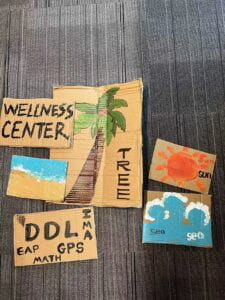
We used cardboard with paintings to display different objects he encounters in the virtual world and also different settings in the play. When he dives into the virtual world, other team members follow and surround the student, take turns to present the signs to both the audience and also the student for him to interact with them.
What is successful, as what one of our professors commented, is that we used different things to show the device’s functions in different senses, for example, the sun for the temperature and the trees for the vision. Also, the idea to have every member gathering together, following the move of the main characters is also a creative way of showing the virtual world created by the device.
What might still need to be improved is that the wires might be unnecessary, for the wireless technology has been well developed these days, and the wires might make it difficult for the users to wear the device, which is exactly what we encountered during the performance–we had to let two other members assist the student during the wearing process.
Evaluation of Another Group
I would like to make a personal evaluation for Group Two.
First of all, I would like to say that I really like the performance from Group Two. The performance took the format of museum touring, in which a group of six encountered a special device. After experimenting it, the group discovered that the device could overlay the pain of the people around and concentrate it on the person in the center. The performance is simple but vivid, showing clearly what the device is and how it works. I really like the clearance there.
The artifact is highly connected with fiction 2, The Ones Who Walk Away from Omelas. In the fiction, there is a girl who suffers from extremely inhumane living conditions, which is the price of the harmonious, happy living of all the citizens in Omelas. Similarly, the device Group Two created collects pain from other people and let one single person suffer, which is really worth thinking and discussing.
I think the device also meets the criteria of interaction. It takes pain as input, and output pain to the chosen person who need to bear it all alone. Then the people around feel the release of the pain, and the people in the center feel the sum of the pain. I think the concept is really good in this project.
However, I think they can still make some improvements. For example, I think their idea of the project is kind of too simple. Based on the concept of the fiction, there could still be some more colorful and interesting ideas that could be applied to the device, rather than simply collecting pain and output it. Also, the performance could be more vivid and dramatic. I think the plot is good, but kind of too flat. Maybe some plot twists would make it better.